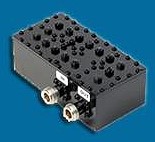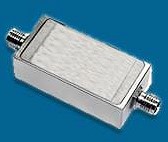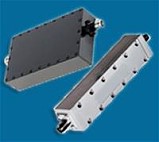Anatech Electronics Newsletter - October 2017 |


Press Release Archives: 2024 | 2023 | 2022 | 2021 |2020 2019 | 2018 | 2017 | 2016 | 2015 2014 | 2013 | 2012 | 2011 | 2010 2009 | 2008 | 2007 | 2006 | 2005 Content is copyright of company represented. Page format, custom text and images are RF Cafe copyright - do not distribute. Anatech Electronics, a manufacturer of RF and microwave filters, has published its October newsletter. In it, Sam Benzacar asks the question "Whatever happened to NFC?" He does a brief history on the big plans for near field communication (NFC) as well as what likely doomed it - at least as originally envisioned. Finally, Sam suggests a great application for NFC that, combined with contactless charging (my interjection), could prove to be a huge market to resurrect NFC fever. There are also a few news items relevant to Anatech Electronics' business (that would be RF filters). A Word from Sam Benzacar 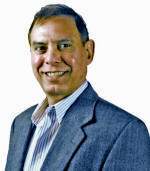 What Ever Happened to NFC? By Sam Benzacar Among the seemingly endless wireless communications standards, near-field communications (NFC) appears to be the winner in the crashed-and-burned category. Of course, there's always WiMAX, which most people believe was killed off by LTE but it's still around, although with much-diminished stature. But the story about NFC is more interesting because there seems to be no reason why it hasn't taken flight. NFC is best known as the enabler of so-called mobile wallets like Apple Pay, Android Pay, and a few others. It supposedly will produce global revenue of more than $7 billion this year with huge numbers of NFC tags in operation. If that's so, where are they? I'll bet few readers have ever seen an NFC tag or ever used NFC, even for paying at the supermarket. Although Google got into NFC sooner and far more deeply than Apple allowing developers to come up with applications, Apple (true to form) only began supporting applications other than Apple Pay with iOS 11 (i.e., last month). There are admittedly other examples of successful NFC applications, such as pairing Bluetooth headsets, media players, and speakers. Video game manufacturers use NFC to unlock features and the toy industry lets uses NFC tags to allow people to customize dolls, figurines, and other products so each one is unique. In countries other than the U.S., people use it for everything from paying for parking meters to their subway ride. Practically speaking, what separates NFC from RFID is (among other things) that the distance between the tag and reader can be only about 4 inches or so. In most wireless scenarios this would be laughable but for NFC it's what makes the technology appealing, as the small distance between the two devices makes data transfer very secure, so it's a natural for point-of-sale applications. Except nobody is using mobile wallets apps in the U.S. (only 5% of people pay with them) and the reason is probably that as credit card issuers pick up costs related to fraud, users don't care about security. And people are so accustomed to paying with a card that trying something new for the sake of security and a minimal increase in convenience isn't worth the effort. But this is only one thing NFC can be used for and it's not the most appealing. For example, I'm as cheap as anyone when it comes to using less cellular data, but getting into the Wi-Fi network at most stores is truly annoying, so I don't. But if retailers, coffee shops and the like put NFC tags on tables, a wall, or some other conspicuous place, I'd just have to tap the tag with the phone and I'd be connected. Yes, it's that simple, but have you ever seen NFC tags anywhere? I haven't – and I've looked. And how about this: A liquor store chain put NFC tags on the shelves to let customers who aren't wine connoisseurs open a Web page to learn about every wine or liquor in the store. It's a whole lot easier than using a QR code. A huge number of things NFC can be performed with NFC but whether they're ever developed remains to be seen. So far it doesn't look promising. Project Loon Helps Puerto Rico
Target Lights up Its Marketing
Radar Shows Interesting Returns
U.S. Mobile Data Speed Ranking: 59th
Check out Our Filter Products
Cavity Band Pass Filters LC Band Pass Filters Cavity Bandstop/Notch Filter About Anatech Electronics Anatech Electronics, Inc. (AEI) specializes in the design and manufacture of standard and custom RF and microwave filters and other passive components and subsystems employed in commercial, industrial, and aerospace and applications. Products are available from an operating frequency range of 10 kHz to 30 GHz and include cavity, ceramic, crystal, LC, and surface acoustic wave (SAW), as well as power combiners/dividers, duplexers and diplexers, directional couplers, terminations, attenuators, circulators, EMI filters, and lightning arrestors. The company's custom products and capabilities are available at www.anatechelectronics.com. Contact: Anatech Electronics, Inc. 70 Outwater Lane Garfield, NJ 07026 (973) 772-4242
Posted October 20, 2017 |
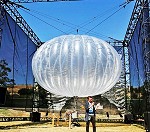 Google
has gotten the OK from the FCC to deploy its solar-powered Project Loon balloon-based Web
service to help restore cellular service to Puerto Rico. It's been used before after heavy
flooding in Peru where its balloons managed to provide basic Internet connectivity to tens
of thousands of people. As this was written, millions of people in Puerto Rico were still
without any way to communicate to the U.S. or elsewhere. The FCC said Alphabet (Google's parent
company) has consent agreements to use the spectrum of Puerto Rico carriers and will work
on starting commercial service using its balloons. The company has flown them almost 12 million
miles in test flights.
Google
has gotten the OK from the FCC to deploy its solar-powered Project Loon balloon-based Web
service to help restore cellular service to Puerto Rico. It's been used before after heavy
flooding in Peru where its balloons managed to provide basic Internet connectivity to tens
of thousands of people. As this was written, millions of people in Puerto Rico were still
without any way to communicate to the U.S. or elsewhere. The FCC said Alphabet (Google's parent
company) has consent agreements to use the spectrum of Puerto Rico carriers and will work
on starting commercial service using its balloons. The company has flown them almost 12 million
miles in test flights. Target
is about to deploy the world's largest lighting-based indoor positioning system using Bluetooth
mesh with ICs embedded in LED ceiling lights from Acuity Brands. Target will send signals
to shoppers' phones and using the company's app the phones will display an interactive map
that guides people around the aisles. Target was initially considering visible communication
(VLC) that uses modulated light rather than RF. Bluetooth's location accuracy is only about
8 ft. while VLC can pinpoint something to within 10 in. but the phone must be pointing at
the ceiling.
Target
is about to deploy the world's largest lighting-based indoor positioning system using Bluetooth
mesh with ICs embedded in LED ceiling lights from Acuity Brands. Target will send signals
to shoppers' phones and using the company's app the phones will display an interactive map
that guides people around the aisles. Target was initially considering visible communication
(VLC) that uses modulated light rather than RF. Bluetooth's location accuracy is only about
8 ft. while VLC can pinpoint something to within 10 in. but the phone must be pointing at
the ceiling.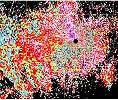 Radar often
detects birds, locusts, and grasshoppers but meteorologists at the National Weather Service
in Colorado recently saw a huge swarm of butterflies near Denver. NWS posted an image on social
media and asked people if they could identify the kind of bird forming the swarm but people
in the area responded that the swarm was actually butterflies. They were identified as painted
ladies, which look like the legendary monarch and have been massing along Colorado's Front
Range over the past few weeks to feed on flowers.
Radar often
detects birds, locusts, and grasshoppers but meteorologists at the National Weather Service
in Colorado recently saw a huge swarm of butterflies near Denver. NWS posted an image on social
media and asked people if they could identify the kind of bird forming the swarm but people
in the area responded that the swarm was actually butterflies. They were identified as painted
ladies, which look like the legendary monarch and have been massing along Colorado's Front
Range over the past few weeks to feed on flowers. The
U.S. is far from setting records in mobile data, at an average of 15 Mb/s. The top four are
Singapore at 45.62, South Korea with 43.4, Hungary with 42.61 and Norway with 41.36 Mb/s.
The U.S. is 59th. Although U.S. speeds have increased every year, they're doing so at a comparative
snail's pace. However, the country is also far larger than the Top Four combined and has a
much larger population and huge rural areas where service is mediocre at best.
The
U.S. is far from setting records in mobile data, at an average of 15 Mb/s. The top four are
Singapore at 45.62, South Korea with 43.4, Hungary with 42.61 and Norway with 41.36 Mb/s.
The U.S. is 59th. Although U.S. speeds have increased every year, they're doing so at a comparative
snail's pace. However, the country is also far larger than the Top Four combined and has a
much larger population and huge rural areas where service is mediocre at best.